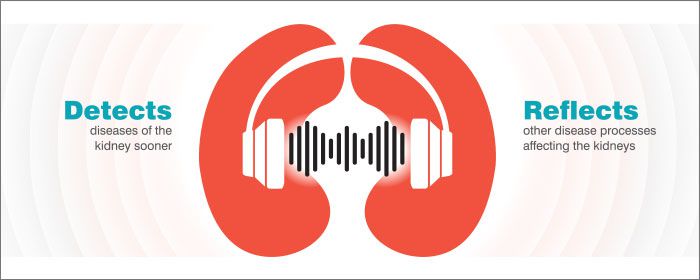IDEXX Reference Laboratories
DISCOVER MORE News
What are their kidneys telling you?
New standard of care for monitoring kidney function "detects and reflects” disease

Breakthrough IDEXX SDMA testing expands veterinary toolkit, allows for unprecedented insight into kidney function
In veterinary medicine, we strive to preserve the bond between our clients and our patients for as long as science and economics permit. Toward that end, we look to advances in diagnostic science to help us detect abnormalities early and reliably, which will afford us the best chance of modifying or reversing underlying disease processes.
The kidneys, in particular, have much to tell us. They serve both as vital organs deserving protection and as natural biosensors, sensitive to conditions in other body systems that affect kidney function. The closer we can listen to the kidneys, the better equipped we are to act on what they divulge.
SDMA: A new standard of care
We now have a tool that enables us to listen to the kidneys more closely than ever. Symmetric dimethylarginine (SDMA) testing has emerged as a new standard of care for monitoring kidney function—a more sensitive, reliable, and early indicator of reduced glomerular filtration rate (GFR) than creatinine.1–5 SDMA can detect as little as a 25% decline in kidney function, long before any abnormality is picked up by creatinine.1,2
SDMA is largely unaffected by confounding factors such as lean body mass or the muscle-wasting effects of hyperthyroidism.4,5,7,8 That is because SDMA is produced in all cells of the body, whereas creatinine is specifically a product of muscle metabolism.
SDMA detects and reflects
IDEXX SDMA testing adds value across a range of diagnostic needs. Think of it as the diagnostic equivalent of a car’s “check engine” light—a call for further investigation.
An increased SDMA may detect acute or early chronic disease within the kidneys or reflect abnormalities in other organ systems that impact kidney function. An increased SDMA with a normal creatinine, indicating as little as a 25% loss of kidney function, may detect incipient kidney disease at an early and more actionable stage, whereas by the time creatinine and BUN are also elevated, 75% of kidney function may be lost.1–3 Elevation of SDMA could also signal potentially reversible contributors to kidney dysfunction, such as pyelonephritis or other infections.6
A new normal for uncovering the abnormal
Already extensively studied and validated in dogs and cats, SDMA testing is included in the current International Renal Interest Society (IRIS) guidelines.9 The IDEXX SDMA Test is part of the routine chemistry panel at IDEXX Reference Laboratories. It can also be performed in-house with the Catalyst SDMA Test for use with the Catalyst One and Catalyst Dx chemistry analyzers.
Having amassed one of the largest databases on kidney function in cats and dogs of all ages and breeds, IDEXX finds that SDMA has identified more than twice as many pets with early loss of kidney function than traditional methods.7 This is in line with numerous peer-reviewed scientific studies that showcase the benefits of SDMA.7
From routine wellness screenings to rooting out underlying causes of acute or chronic symptoms, SDMA is an essential part of the chemistry panel. It is what GFR determination looks like in the twenty-first century.
References
- Nabity MB, Lees GE, Boggess M, et al. Symmetric dimethylarginine assay validation, stability, and evaluation as a marker for early detection of chronic kidney disease in dogs. J Vet Intern Med. 2015;29(4):1036–1044.
- Hall JA, Yerramilli M, Obare E, Yerramilli M, Jewell DE. Comparison of serum concentrations of symmetric dimethylarginine and creatinine as kidney function biomarkers in cats with chronic kidney disease. J Vet Intern Med. 2014;28(6):1676–1683.
- Hall JA, Yerramilli M, Obare E, Yerramilli M, Almes K, Jewell DE. Serum concentrations of symmetric dimethylarginine and creatinine in dogs with naturally occurring chronic kidney disease. J Vet Intern Med. 2016;30(3):794–802.
- Hall JA, Yerramilli M, Obare E, Yerramilli M, Yu S, Jewell DE. Comparison of serum concentrations of symmetric dimethylarginine and creatinine as kidney function biomarkers in healthy geriatric cats fed reduced protein foods enriched with sh oil, L-carnitine, and medium-chain triglycerides. Vet J. 2014;202(3):588–596.
- Hall JA, Yerramilli M, Obare E, Yerramilli M, Melendez LD, Jewell DE. Relationship between lean body mass and serum renal biomarkers in healthy dogs. J Vet Intern Med. 2015;29(3):808–814.
- Yerramilli M, Yerramilli M, Obare E, Jewell DE, Hall JA. Symmetric dimethylarginine (SDMA) increases earlier than serum creatinine in dogs with chronic kidney disease (CKD). [ACVIM Abstract NU-42]. J Vet Intern Med. 2014;28(3):1084–1085.
- Data on file at IDEXX Laboratories, Inc. Westbrook, Maine USA.
- Vaske HH, Armbrust L, Zicker SC, Jewell DE, Grauer GF. Assessment of renal function in hyperthyroid cats managed with a controlled iodine diet. Int J Appl Res Vet Med. 2016;14(1):38–48.
- International Renal Interest Society. 2015 IRIS CKD Staging Guidelines. www.iris-kidney.com/guidelines. Accessed April 8, 2019.